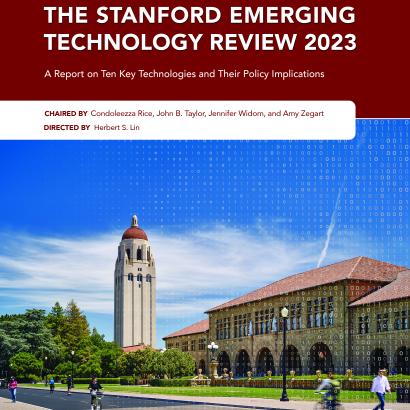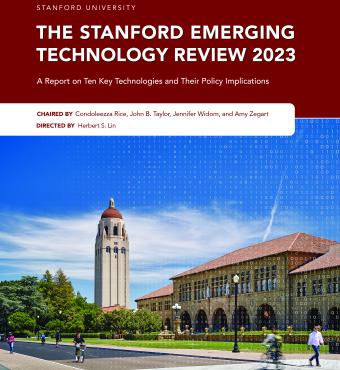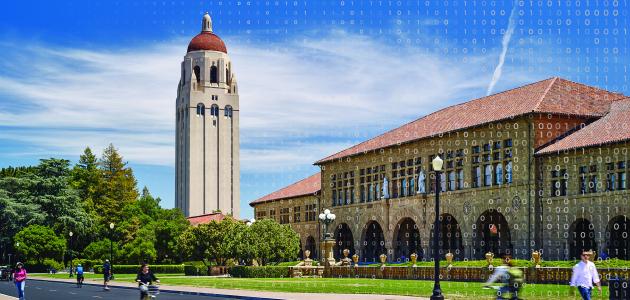Today marks the release of the inaugural report of the Stanford Emerging Technology Review, the product of a major new technology education initiative for policy makers. It was created to be an easy-to-use reference tool that harnesses the expertise of Stanford University’s leading science and engineering faculty in ten major areas: artificial intelligence, biotechnology and synthetic biology, cryptography, sustainable energy technologies, materials science, neuroscience, nuclear technologies, robotics, semiconductors, and space. Download the full report here and subscribe here for news and updates.
Emerging technologies are transforming societies, economies, and geopolitics. This moment brings unparalleled promise and novel risks. In every era, technological advances buoy nations that develop and scale them—helping to save lives, win wars, foster greater prosperity, and advance the human condition. At the same time, history is filled with examples where slow-moving governments stifled innovation in ways policy makers never intended, and nefarious actors used technological advances in ways that inventors never imagined.
Technology is a tool. It is not inherently good or bad. But its use can amplify human talent or degrade it, uplift societies or repress them, solve vexing challenges or exacerbate them. These effects are sometimes deliberate but often accidental.
The stakes of technological developments today are especially high. Artificial intelligence (AI) is already revolutionizing industries, from music to medicine to the military, and its impact has been likened to the invention of electricity. Yet AI is just one among many technologies that are ushering in profound change. Fields like synthetic biology, materials science, and neuroscience hold potential to vastly improve health care, environmental sustainability, economic growth, and more. We have experienced moments of major technological change before. But we have never experienced the convergence of so many technologies with the potential to change so much, so fast.
The goal of the Stanford Emerging Technology Review is to help both the public and private sectors better understand the technologies poised to transform our world so that the United States can seize opportunities, mitigate risks, and ensure the American innovation ecosystem continues to thrive.
Our efforts are guided by four observations:
Policy makers need better resources to help them understand technological developments faster, continuously, and more easily.
Technology policy increasingly requires a more sophisticated understanding across a broad range of fields and sectors. Indeed, policy makers today include an expanding array of decision makers, from legislators and executive branch officials in Washington to state and local governments, investors, and corporate leaders. Too often, government leaders lack technical expertise to understand scientific developments, while technologists lack the policy expertise to consider and build security, safety, and other societal considerations into their products by design. Key takeaways of this report, for example, include the following findings that may be surprising and even counterintuitive to non-experts:
• Artificial intelligence has received a great deal of media attention, but biotechnology could ultimately be as transformational to society as computing.
• Space technologies are increasingly critical to everyday life, from GPS navigation to banking. But space is a planetary resource that is rapidly becoming congested and contested—with thousands of new commercial satellites and an estimated million pieces of space debris that could threaten access to these global commons.
• The most significant challenge to achieving sustainable energy is scale; simply providing a seventy-two-hour supply of backup energy worldwide would take two hundred years of lithium-ion battery production.
• Cryptocurrencies are not the most important issue in cryptography today, and they are not synonymous with blockchain.
Policy makers need to understand technological basics and new discoveries before crises emerge; to focus their attention on the most important issues; to better assess the policy implications; and to see over the horizon to shape, accelerate, and guide technological innovation and applications. We need a new model of technology education for non-technical leaders. This report aims to be a first, important step.
America’s global innovation leadership matters.
American innovation leadership is not just important for the nation’s economy and security. It is the linchpin for maintaining a dynamic global technology innovation ecosystem and securing its benefits.
International scientific collaboration has long been pivotal to fostering global peace, progress, and prosperity, even in times of intense geopolitical competition. During the Cold War, for example, American and Soviet nuclear scientists and policy makers worked together to reduce the risk of accidental nuclear war through arms control agreements and safety measures. Today, China’s rise poses many new challenges. Yet maintaining a robust global ecosystem of scientific cooperation remains essential—and it does not happen by magic. It takes work, leadership, and a fundamental commitment to freedom to sustain the openness essential for scientific discovery. Freedom is the fertile soil of innovation, and it takes many forms: the freedom to criticize a government; to admit failure in a research program as a step toward future progress; to share findings openly with others; to collaborate across geographical and technical borders with reciprocal access to talent, knowledge, and resources; and to work without fear of repression or persecution. In short, it matters whether the innovation ecosystem is led by democracies or autocracies.
Academia’s role in American innovation is essential yet increasingly at risk.
The US innovation ecosystem has three pillars: the government, the private sector, and the academy. Success requires that all three remain robust and actively engaged. America’s research universities have generated transformational scientific discoveries, from the invention of the polio vaccine to rocket fuel. Universities have also been the seedbeds of policy innovations, from nuclear deterrence theory to behavioral economics. And they have played a vital role in training the next generation.
Today, however, innovations are increasingly emerging from the private sector, often alongside academia. The funding sources for innovation have shifted, too—in deeply worrying ways. The US government is the only funder capable of making large and risky investments in the basic science conducted at universities (and national laboratories) that is essential for future applications. Yet federal research and development (R&D) funding has plummeted since the 1960s, from 1.86 percent of GDP in 1964 to just 0.66 percent of GDP in 2016. Although private sector investment in technology companies and associated university research has increased substantially, it is no substitute; federal funding of university research leads universities to study different technological challenges and opportunities than industry funding does.
To be sure, the rising dominance of private industry in innovation brings significant benefits. But it is also generating serious and more hidden risks to the health of the entire American innovation ecosystem. Universities and companies are not the same. Companies must answer to investors and shareholders, who expect returns on their capital investments, so they tend to focus on technologies that can be commercialized in the foreseeable future. Research universities, by contrast, operate on much longer time horizons without regard for profit, engaging in fundamental research at the frontiers of knowledge that has little if any foreseeable commercial benefit. This fundamental research is the foundation for future applications that may take years, even decades, to emerge. For instance, it took decades of research in number theory—a branch of pure mathematics—to develop the modern cryptography that is widely used to protect data.
Today, technology and talent are migrating from academia to the private sector, accelerating the development of commercial products while eroding the foundation for the future.
These trends raise several concerning implications. Among them: research in the field is likely to be skewed to applications driven by commercial rather than public interests. The ability for universities—or anyone outside of the leading AI companies—to conduct independent analysis of the weaknesses, risks, and vulnerabilities of AI (especially large language models recently in the news) will become more important and simultaneously more difficult. Further, the more that industry offers unparalleled talent concentrations, computing power, training data, and the most sophisticated models, the more likely it is that future generations of the best AI minds will continue to flock there—hollowing out university faculty and eroding the nation’s ability to conduct broad-ranging foundational research in the field.
The view from Stanford is unique, important—and needed now more than ever.
Stanford University has a unique vantage point when it comes to technological innovation. It is no accident that Silicon Valley surrounds Stanford; the university lies at the heart of the innovation ecosystem. Stanford faculty, researchers ,and former students have founded Alphabet, Cisco Systems, Hewlett-Packard, Instagram, LinkedIn, Nvidia, Sun Microsystems, Yahoo, and many other companies, together generating more annual revenues than most of the world’s economies. Startups take flight in our dorm rooms, classrooms, laboratories, and kitchens. Technological innovation is lived every day and up close on our campus—with all its benefits and downsides. This ecosystem’s culture, ideas, and perspectives often seem a world apart from the needs and norms of Washington, DC. Bridging the divide between the locus of American policy and the heart of American technological innovation has never been more important.
Stanford has a rich history of policy engagement, with individuals who serve at the highest levels of government as well as institutional initiatives that bring together policy makers and researchers to tackle the world’s toughest policy problems. But in this moment of rapid technological change, we must do more. We, the co-chairs of this exciting project, are delighted to launch this unprecedented collaboration between Stanford’s Hoover Institution and the School of Engineering to bring policy analysis, social science, science, medicine, and engineering together.
In setting out to harness the latest insights from leading scholars in ten of the most important fields today—fields that are rapidly shaping American society and promise to be even more important in the coming years—we selected these ten as a starting point, not an endpoint. We wanted to begin by leveraging areas of deep expertise at Stanford and covering technologies widely recognized as essential for expanding American economic prosperity, advancing democratic values, and protecting the security of the nation. But science is always moving, and we expect that future reports may select different areas or divide fields in different ways.
Three points bear noting. First, we offer no specific policy recommendations. That is by design. Washington is littered with reports offering policy recommendations that were long forgotten, overtaken by events, or both. We want to provide a reference resource that endures—a report that is updated and issued annually, a guide that can inform successive generations of policy makers about evolving technological fields and their implications.
Second, the SETR offers a view from Stanford, not the view from Stanford. There is no single view of anything in a university. The report is intended to reflect the best collective judgment about the state of these ten fields—guided by leading experts in those fields.
Third, this report is just the beginning. In the months ahead, SETR will produce deep-dive reports on the ten technological areas, holding briefings in California and Washington, DC, and launching multimedia educational products. Our goal is to develop a new model to help policy makers understand tech issues in a more real-time, continuous, rigorous, and user-friendly way.
Ensuring American leadership in science and technology requires all of us—academia, industry, government—to keep listening, learning, and working together. We hope the Stanford Emerging Technology Review starts meaningful and lasting conversations about how an innovation ecosystem benefits us all. The promise of emerging technology is boundless if we have the foresight to understand it and the fortitude to embrace the challenges.

















